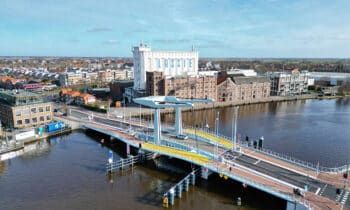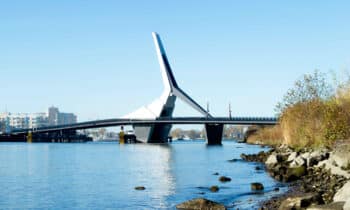
Symbolic railroad bridge replaced by world's first network arch bridge
Smart solution to move complete structure saves time and minimizes disruption
The 2,100-ton, 180-meter-long bridge will help increase line capacity and reduce travel times by allowing a maximum permitted speed of 120 mph.

Mammoet has extensive experience with large-scale bridge launches and the specialized heavy lifting equipment to move them as complete structures. This enables parallel work in the preparation phase and saves time. It was therefore approached to install the bridge safely and with minimal disruption.
Challenging and changing water levels
The bridge was assembled on the German side of the Oder River and then moved by Mammoet as a whole across the river to its final installation position. Koen Brouwers, Project Manager at Mammoet, said, "Most bridges are sailed into place using a combination of Mammoet Self-Propelled Modular Transporters (SPMTs), launch pads and a pontoon. However, the use of a pontoon was not possible here because of the river's shallow and changing water levels. The use of a large crane, capable of positioning long-reach loads, was also not feasible due to the weight and length of the bridge." Mammoet's engineers therefore came up with a solution that avoided the use of both crane and pontoon. This solution made it possible to work regardless of the water level and made the operation more flexible, safe and efficient.

After the bridge was jacked up to 2 meters and the SPMTs positioned under it, it was transported to the river's edge and placed over the first of five temporary supports. The bridge was then launched using a combination of specially designed launch plates and strand jackets that pulled the structure horizontally until it reached the next temporary support. This process continued until the bridge reached the other side of the river. The SPMTs at the rear of the bridge were then removed and sliding plates were installed to slide the bridge to its final position.
At this point, the bridge was taken over by climbingjacks, allowing the temporary supports to be removed and the bridge to be lowered to its final resting height. Approximately 45 truckloads of specialized heavy equipment were mobilized for this project, including 96 axle lines of SPMTs, 26 launch plates, 10 climbjacks and 2 strandjacks.
Rotating plates
One of the main considerations in any bridge launch is the risk of deformation of the structure during the launch process, and this presented a major challenge for the engineering team. To solve this, temporary supports with hydraulic cylinders were used at the quay sides and in the water, as well as modified launch plates. Jack van der Vloet, Lead Engineer at Mammoet: "It's a big bridge and wind loads had to be considered. It has a big deflection, so the launch plates had to be modified. Normally they rotate in two directions. In this case, however, they had to rotate 360 degrees. This gave us full control of the operation at all times."
The entire sliding equipment had to be modified to technically perform the operation. This meant that all launch plates were fitted with spherical bearings so that they could be moved in all directions. During launch, the weight on each tower and cylinder was controlled to ensure smooth and safe operation. Due to the size of the bridge, all available launch plates that Mammoet Europe had in stock had to be used. This was a technical and logistical challenge, but easily handled thanks to Mammoet's size and network.

New method for success
Infrastructure projects are critical to support growing populations and economies, and as cities become busier, these projects become more challenging. Mammoet's experience in large-scale bridge projects and technical ability to move bridges as complete structures enables parallel work in the preparation phase and time and disruption savings. Uwe Richter, Senior Sales Manager at Mammoet: "It is very important to involve Mammoet at an early stage to support the preparation phase with technical and feasibility studies. This way, we can examine the different implementation options and determine the best solution together with the customer."
Compared to other bridge projects where cranes or pontoons are used, Mammoet used a different method with modified launch plates. This clever solution can now be adapted for other bridge projects where the use of a crane or pontoon is not possible or inefficient.




